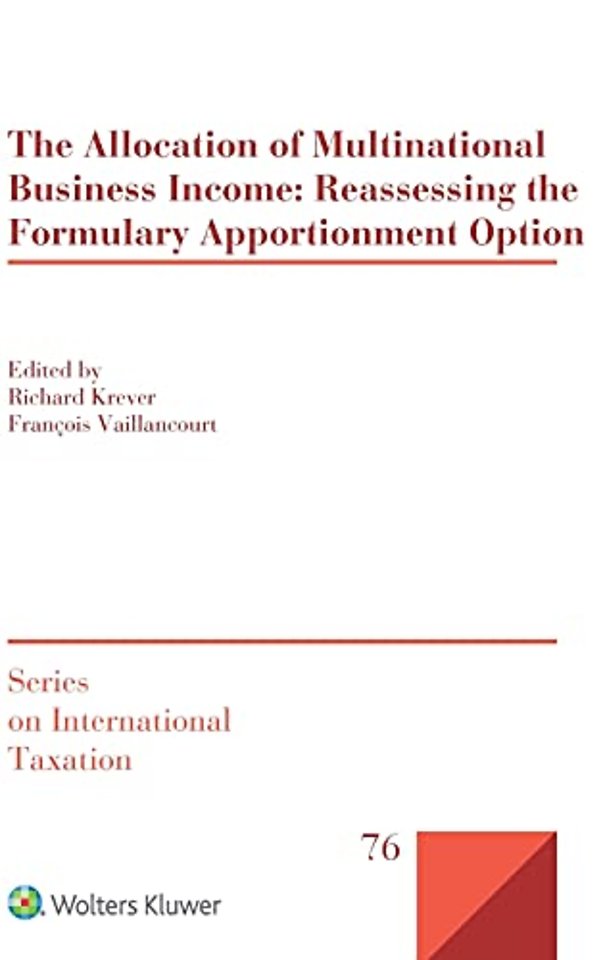The Allocation of Multinational Business Income
Reassessing the Formulary Apportionment Option
Samenvatting
Series on International Taxation Volume 76
The Allocation of Multinational Business Income is a global guide to formula apportionment providing a comprehensive understanding of aspects of the formulary apportionment option. Although an arm’s length methodology continues to prevail in international taxation policy, it has long been replaced by the formulary apportionment method at the subnational level in a few federal countries. Its use is planned for international profit allocation as an element of the European Union’s CCCTB proposals. In this timely book, a knowledgeable group of contributors from Australia, Canada, the United Kingdom and the United States address this actively debated topic, in respect of both its technical aspects and its promise as a global response to the avoidance, distortions, and unfairness of current allocation systems.
What’s in this book:
Drawing on a wealth of literature considering formula apportionment in the international sphere and considering decades of experience with the system in the states and provinces of the United States and Canada, the contributors explicate and examine such pertinent issues as the following:
- the debate about what factors should be used to allocate profits under a formulary apportionment system and experience in jurisdictions using formulary apportionment;
- application of formula apportionment in specific sectors such as digital enterprises and the banking industry;
- the political economy of establishing and maintaining a successful formulary apportionment regime;
- formulary apportionment proposals for Europe;
- role of traditional tax criteria such as economic efficiency, fairness, ease of administration, robustness to avoidance and incentive compatibility;
- determining which parts of a multinational group are included in a formula apportionment unit; and
- whether innovative profit-split methodologies such as those developed by China are shifting traditional arm’s length methods to a quasi-formulary apportionment system.
How this will help you:
Having a realistic appreciation of the prospects for adoption of formulary apportionment in Europe and globally, this state of the art summary of history, current practice, proposals and prospects in the ongoing debate over arm’s length versus formulary apportionment methodologies will be welcomed by practitioners, policymakers, and academics concerned with international taxation, all of whom will gain an understanding of the case put forward by proponents for adoption of formula apportionment in Europe and globally and the counterarguments they face. Readers will acquire a better understanding of the implications of formulary apportionment and its central role in the current debate about the future of international tax rules.
Specificaties
Inhoudsopgave
Contributors
Acknowledgements
Introduction: Reassessing the Formulary Apportionment Option
Richard Krever & François Vaillancourt
PART I
The Story to Date
CHAPTER 1
History and Theory of Formulary Apportionment
Richard Krever & Peter Mellor
CHAPTER 2
The US States’ Experience with Formulary Apportionment
Shirley Sicilian & Joe Huddleston
CHAPTER 3
Formulary Apportionment in Canada and Taxation of Corporate Income in 2019: Current Practice, Origins and Evaluation
Michael Smart & François Vaillancourt
CHAPTER 4
The Dream Is Alive: EU Tax Policy with a Common Consolidated Corporate Tax Base and Formulary Apportionment
Joann Martens Weiner
CHAPTER 5
The Application of Formulary Apportionment to Related Entities: Lessons from the US Experience
Walter Hellerstein
PART II
Future Possibilities: Variations on the Formulary Apportionment Theme
CHAPTER 6
Is Unilateral Formulary Apportionment Better than the Status Quo?
J. Clifton Fleming, Jr., Robert J. Peroni & Stephen E. Shay
CHAPTER 7
A Framework for Assessing Business Sector Formulary Apportionment
Kerrie Sadiq
PART III
The Evolving Intersections of Arm’s Length Pricing and Formulary Apportionment and Alternatives
CHAPTER 8
Between Arm’s Length and Formulary Apportionment
Yariv Brauner
CHAPTER 9
Is Arm’s Length Profit Split Methodology Morphing into a Formulary Apportionment Hybrid: The Chinese Example
Fei Gao & Antony Ting
PART IV
Formulary Apportionment in an Evolving International Tax System
CHAPTER 10
Value Creation and the Allocation of Profits under a Formulary Apportionment System
John Vella
CHAPTER 11
Formulating the International Tax Debate: Where Does Formulary Apportionment Fit?
Itai Grinberg
PART V
Can International Tax Sharing Become Reality?
CHAPTER 12
International Tax Sharing: Can the Dream Become Reality?
Richard Bird & Jack Mintz
Index
Anderen die dit boek kochten, kochten ook
Net verschenen
Rubrieken
- aanbestedingsrecht
- aansprakelijkheids- en verzekeringsrecht
- accountancy
- algemeen juridisch
- arbeidsrecht
- bank- en effectenrecht
- bestuursrecht
- bouwrecht
- burgerlijk recht en procesrecht
- europees-internationaal recht
- fiscaal recht
- gezondheidsrecht
- insolventierecht
- intellectuele eigendom en ict-recht
- management
- mens en maatschappij
- milieu- en omgevingsrecht
- notarieel recht
- ondernemingsrecht
- pensioenrecht
- personen- en familierecht
- sociale zekerheidsrecht
- staatsrecht
- strafrecht en criminologie
- vastgoed- en huurrecht
- vreemdelingenrecht







